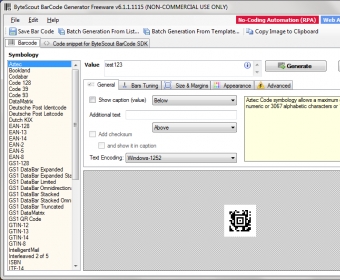

When a PDF417 symbol is created, complex software algorithms are used to analyze the data to be encoded and use the most appropriate compaction mode, often times switching between modes within the symbol. Numeric strings of fewer than 13 digits are typically encoded using Text Compaction Mode. This mode is most effective for strings of 13 or more numeric digits.

#Pdf417 barcode maker mod#
Z = (error correction level) * 3 + (number of rows – 1) mod 3 These values are computed based on the cluster, row number, the total number of rows, the number of data columns, and the error correction level being used (see Error Correction below) using the formulas below: The first and last characters in a row are the start and stop pattern while the second character and second to last character are the left row indicator and the right row indicator respectively. Since all symbol characters in a given row are from the same cluster and adjacent rows always use different clusters, scanning equipment can detect when a scan crosses from one row to another (especially linear scanners like laser). The first row of the symbol uses cluster 0 the second row cluster 3 the third row cluster 6 the fourth row begins again at cluster 0. Mod 9 = modulo division (the integer remainder of the division)Īs an example, here is the equation for the cluster 3 character:Ĭluster number = (5 – 1 + 1 – 2 + 9) mod 9Ĭluster number = 12 mod 9 (12 / 9 = 1 remainder 3)Įach row of a PDF417 symbol uses symbol characters from a single cluster. The cluster number can actually be derived from the character pattern, using the following formula: As an example, here is codeword 0 as it would be represented in each of the clusters (greatly enlarged):

PDF417 uses three distinct symbol sets called clusters within each cluster, each character is assigned a value between 0 and 928. Laser scanners typically cannot read symbols that use less than 3X for the module height. The specification for PDF417 requires that a symbol character’s height be at least 3 times the module width, though there are some instances where 2X and even 1X have been used. Symbol characters in PDF417 are typically referred to as codewords, especially those used to represent the data portion of the symbol. Each bar/space can be from 1 to 6 modules in width. The only exception is the stop symbol which is 19 modules. Here are the examples again, diagramed for clarity:Įach symbol character consists of 4 bars and 4 spaces with a total width of 17 modules (hence the origin of 417 in the symbology’s name). In the examples above, the first symbol has 16 rows and 1 data column, while the second symbol has just 4 rows but 5 data columns. The number of data characters in each row is typically referred to as the number of data columns in the symbol. Both symbols have encoded the exact same data, but are using different layout options:Ī PDF417 symbol consists of 3 to 90 stacked rows of bar/space patterns. PDF417 barcodes are variable in size and layout, most commonly seen in rectangular configurations. Indeed, this was one of its primary design goals. Unlike most other two-dimensional barcodes though, PDF417 can be scanned with an appropriately configured laser scanner. Strictly speaking, PDF417 is classified as a stacked, linear barcode (similar in structure to the stacked variants of GS1 Databar), though it is often referred to as a two-dimensional barcode since it represents data using multiple rows and columns like Data Matrix. PDF417 (Portable Data File, or PDF-417) was introduced in 1990 by Symbol Technologies (since acquired by Motorola) as a high-capacity, highly secure symbology.


 0 kommentar(er)
0 kommentar(er)
